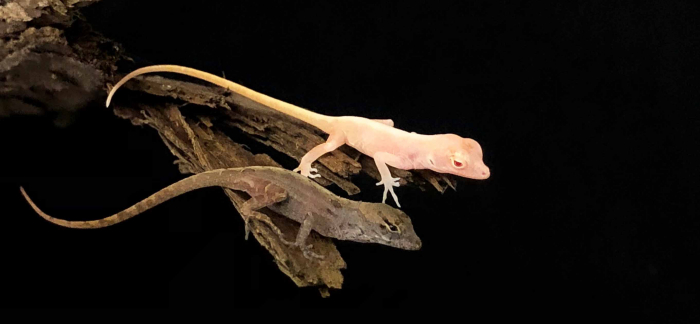The creatures, which are the size of a human index finger, were made using a controversial gene-editing technique called CRISPR-Cas9.
This method has previously been used to change the DNA of mammals, fish, birds and amphibians – but this is the first time it has been used with reptiles.
It was previously thought to be impossible to use the technique on reptiles because, unlike other animals, they fertilise their eggs at unpredictable times.
Embryos are also hard to transfer from a female lizard, making it difficult to manipulate them in a lab as has been done with other animals’ embryos.
CRISPR-Cas9 – usually just called CRISPR – works like a pair of molecular scissors that can insert, delete, modify or replace DNA in the genome of a living organism.
Scientists can use it to disable a gene that is causing problems or supply one that is needed. The technique could lead to curing previously incurable diseases, extending human lifespan or controversially creating “designer babies”.
In this latest study, scientists from the University of Georgia injected CRISPR reagents into unfertilised eggs in lizard ovaries for the first time. When the eggs hatched, about half of the mutant lizards had inherited edited genes on DNA from both their mothers and fathers.
This proves that CRISPR components stay active for several days or even weeks within an unfertilised egg, according to the paper published in Cell Reports.
“For quite some time we’ve been wrestling with how to modify reptile genomes and manipulate genes in reptiles, but we’ve been stuck in the mode of how gene editing is being done in the major model systems,” said lead author Doug Menke, an associate professor at the University of Georgia.
“Because we are injecting unfertilised eggs, we thought that we would only be able to perform gene editing on the alleles [a form of gene] inherited from the mother. Paternal DNA isn’t in these unfertilised oocytes [egg cells].
“We had to wait three months for the lizards to hatch, so it’s a bit like slow-motion gene editing.”
Between 6 and 9 per cent of the oocyctes produced offspring with gene-edited traits.
“Relative to the very established model systems that can have efficiencies up to 80 per cent or higher, 6 per cent seems low, but no one has been able to do these sorts of manipulations in any reptile before,” Professor Menke said.
“There’s not a large community of developmental geneticists that are studying reptiles, so we’re hoping to tap into exciting functional biology that has been unexplored.”
Researchers chose to make the lizards albino partly because humans with albinism often have vision problems. Scientists hope to use the lizards to study how the loss of this gene affects the development of the retina.
The scientists now hope to use this gene-editing technique on other animals.
“We never know where the next major insights are going to come from, and if we can’t even study how genes work in a huge group of animals, then there’s no way to know if we’ve explored everything there is to explore in the realm of gene function in animals,” Professor Menke said.
“Each species undoubtedly has things to tell us, if we take the time to develop the methods to perform gene editing.”
The Independent
More about: science
















































